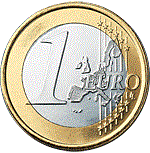
There are eight euro coin denominations, ranging from one cent to two euros. The coins first came into use in 2002. They have a common reverse, portraying a map of Europe, but each country in the eurozone has its own design on the obverse, which means that each coin has a variety of different designs in circulation at once. Four European microstates that are not members of the European Union use the euro as their currency and also have the right to mint coins with their own designs on the obverse side.
Greek euro coins feature a unique design for each of the eight coins. They were all designed by Georgios Stamatopoulos with the minor coins depicting Greek ships, the middle ones portraying famous Greeks and the two large denominations showing images of Greek history and mythology. All designs feature the 12 stars of the EU, the year of imprint and a tiny symbol of the Bank of Greece. Uniquely, the value of the coins is expressed on the national side in the Greek alphabet, as well as being on the common side in the Roman alphabet. The euro cent is known as the lepto in Greek, a name which has also been used for the 1⁄100 denominations of the preceding currencies of the Greek state, the phoenix and drachma.
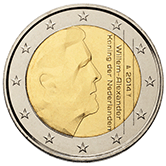
Dutch euro coins currently use two designs by Erwin Olaf, both of which feature a portrait of King Willem-Alexander of the Netherlands. The new designs began circulating in 2014. Dutch Euro coins minted from 1999 to 2013 feature a portrait of Queen Beatrix designed by Bruno Ninaber van Eyben. All coins share the 12 stars of the EU and the year of imprint in their design.
Luxembourgish euro coins feature three different designs, though they all contain the portrait or effigy of Grand Duke Henri of Luxembourg. The designs, by Yvette Gastauer-Claire, also contain the 12 stars of the EU flag, the year of imprint and the name of the country in the Luxembourgish language: Lëtzebuerg.
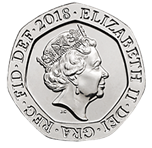
The British decimal twenty pence coin is a denomination of sterling coinage worth 1⁄5 of a pound. Like the 50p coin, it is an equilateral curve heptagon. Its obverse has featured the profile of Queen Elizabeth II since the coin's introduction on 9 June 1982. Four different portraits of the Queen have been used; the latest design by Jody Clark was introduced in 2015. The second and current reverse, featuring a segment of the Royal Shield, was introduced in 2008.

The British two pound (£2) coin is a denomination of sterling coinage. Its obverse has featured the profile of Queen Elizabeth II since the coin’s introduction. Three different portraits of the Queen have been used, with the current design by Jody Clark being introduced in 2015. The reverse design features Britannia.
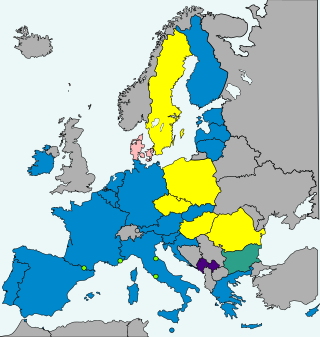
Vatican euro coins are issued by the Philatelic and Numismatic Office of the Vatican City State and minted by Istituto Poligrafico e Zecca dello Stato (IPZS), in Rome, Italy. The euro is the official currency of the Vatican City, although Vatican City is not a member of the Eurozone or the European Union. The euro has been the official currency of Vatican City since 2002. Before that, the Vatican lira was the official currency.
There have been three sets of coins in Ireland since independence. In all three, the coin showed a Celtic harp on the obverse. The pre-decimal coins of the Irish pound had realistic animals on the reverse; the decimal coins retained some of these but featured ornamental birds on the lower denominations; and the euro coins used the common design of the euro currencies. The pre-decimal and original decimal coins were of the same dimensions as the same-denomination British coins, as the Irish pound was in currency union with the British pound sterling. British coins were widely accepted in Ireland, and conversely to a lesser extent. In 1979 Ireland joined the Exchange Rate Mechanism and the Irish pound left parity with sterling; coin designs introduced after this differed between the two countries.
Slovenian euro coins were first issued for circulation on 1 January 2007 and a unique feature is designed for each coin. The design of approximately 230 million Slovenian euro coins was unveiled on 7 October 2005. The designers were Miljenko Licul, Maja Licul and Janez Boljka. The Mint of Finland was chosen to mint the coins through an international tender in 2007.
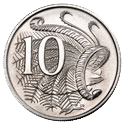
The Australian ten-cent coin is a coin of the decimal Australian dollar. When the dollar was introduced as half of an Australian pound on 14 February 1966, the coin inherited the specifications of the pre-decimal shilling; both coins were worth one twentieth of a pound and were called "bob". On introduction it was the fourth-lowest denomination coin. Since the withdrawal from circulation of the one and two cent coins in 1992, it has been the second-lowest denomination coin in circulation.
The coins of Canada are produced by the Royal Canadian Mint and denominated in Canadian dollars ($) and the subunit of dollars, cents (¢). An effigy of the reigning monarch always appears on the obverse of all coins. There are standard images which appear on the reverse, but there are also commemorative and numismatic issues with different images on the reverse.

The 1 euro cent coin (€0.01) has a value of one hundredth of a euro and is composed of copper-covered steel. It is the lowest-value coin in the Eurozone; the next highest are the 2 and 5 euro cent coins. All euro coins have a common reverse and a country-specific (national) obverse. The coin has been used since 2002 and was not redesigned in 2007 as was the case with the higher-value coins.

The 5 euro cent coin (€0.05) has a value of one twentieth of a euro and is composed of copper-covered steel. All euro coins have a common reverse and country-specific (national) obverse. The coin has been used since 2002 and was not re-designed in 2007 as was the case with the higher-value coins.

The 1 euro coin (€1) is a euro coin with a value of one euro. It is made of two alloys: the inner part of cupronickel, the outer part of nickel brass. All coins have a common reverse side and country-specific national sides. The coin has been used since 2002, with the present common side design dating from 2007.
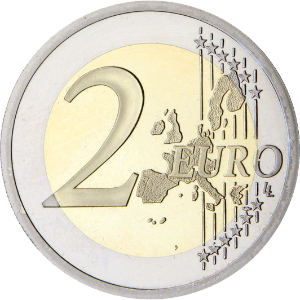
The 2 euro coin (€2) is the highest-value euro coin and has been used since the introduction of the euro in 2002. The coin is used in 22 countries with a collective population of about 341 million. The coin is made of two alloys: the inner part of nickel brass, the outer part of copper-nickel. All coins have a common reverse side and country-specific national sides. The coin has been used since 2002, with the present common side design dating from 2007.
The coins of the Australian dollar were introduced on 14 February 1966, although they did not at that time include the one-dollar or two-dollar coins. The dollar was equivalent in value to 10 shillings in the former currency.
Before the introduction of the euro, the current eurozone members issued their own individual national coinage, most of which featured mint marks, privy marks and/or mint master marks. These marks have been continued as a part of the national designs of the euro coins, as well. This article serves to list the information about the various types of identifying marks on euro coins, including engraver and designer initials and the unique edge inscriptions found on the €2 coins.

Gold and silver issues of the euro commemorative coins are collectors' euro coins not primarily intended for general circulation; the commemoratives also include rare cases of bimetal collector coins, such as titanium and niobium.
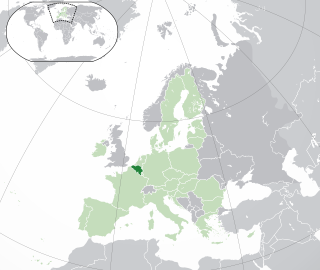
Euro gold and silver commemorative coins are special euro coins minted and issued by member states of the Eurozone, mainly in gold and silver, although other precious metals are also used in rare occasions. Belgium was one of the first twelve countries in the Eurozone that introduced the euro (€) on 1 January 2002. Since then, the Belgian Royal Mint have been minting both normal issues of Belgian euro coins, which are intended for circulation, and commemorative euro coins in gold and silver.

The double sovereign is a gold coin of the United Kingdom with a nominal value of two pounds sterling (£2). Rarely issued in the first century and a half after its debut in 1820, it never had a significant presence in circulation. It is now a collector and bullion coin, and has been struck most years since 1980. It features the reigning monarch on its obverse and, most often, Benedetto Pistrucci's depiction of Saint George and the Dragon on the reverse.
















